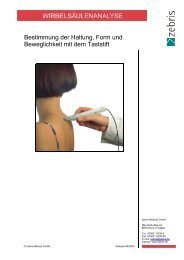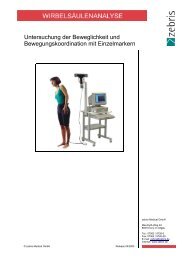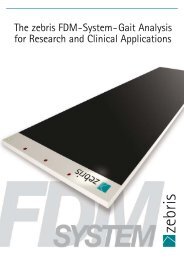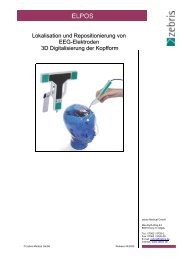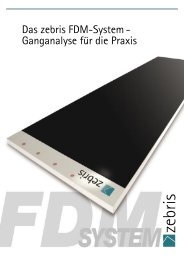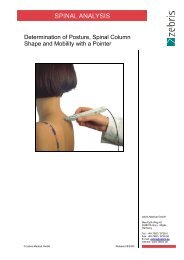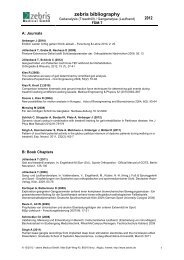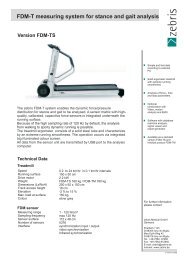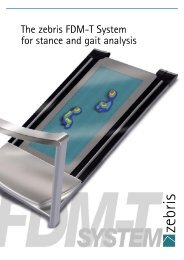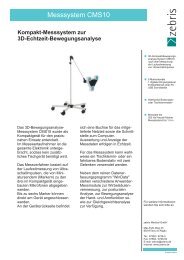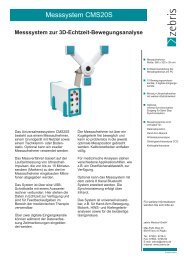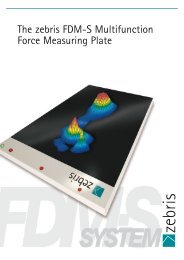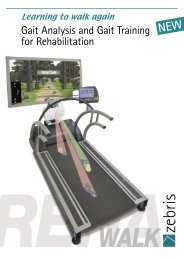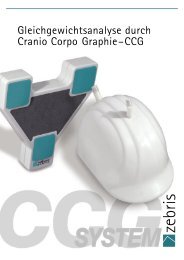Product information Rehawalk - zebris Medical GmbH
Product information Rehawalk - zebris Medical GmbH
Product information Rehawalk - zebris Medical GmbH
Create successful ePaper yourself
Turn your PDF publications into a flip-book with our unique Google optimized e-Paper software.
Learning to walk again<br />
Gait Analysis and Gait Training<br />
for Rehabilitation<br />
NEW
The World of Biomechanics<br />
<strong>Rehawalk</strong>®-A new concept for treati<br />
The <strong>Rehawalk</strong>®<br />
includes a gait analysis<br />
and training<br />
system. The System<br />
includes an<br />
instrumented<br />
treadmill with a<br />
pressure sensor<br />
matrix, a unit for<br />
projecting the step<br />
pattern within the<br />
platform, a screen<br />
for projecting the<br />
individual, virtual<br />
feedback training<br />
and a processing<br />
unit. The system<br />
also has a stress<br />
and balance testing<br />
module.<br />
The evaluation report<br />
on the gait analysis<br />
contains all the important<br />
place and<br />
time parameters,<br />
such as the stance,<br />
swing and doublestanding<br />
phases,<br />
step length, step<br />
width, foot-rotation<br />
angle and a detailed<br />
analysis of the force<br />
distribution under<br />
the feet.<br />
The <strong>zebris</strong> <strong>Rehawalk</strong>®System is<br />
suitable for the treadmill-supported<br />
analysis and treatment of gait<br />
disorders for neurological and<br />
orthopedic rehabilitation. The application<br />
possibilities comprise a<br />
dynamic, visual stimulation by<br />
means of step projection onto the<br />
walking range, as well as a virtual<br />
screen environment. The course<br />
of the treatment is automatically<br />
documented by the system.
ng gait disorders<br />
Underneath the belt<br />
a pressure sensor<br />
matrix is installed<br />
with several thousand<br />
calibrated, capacitive<br />
pressure sensors.<br />
The belt movement<br />
is compensated such<br />
that stable gait and<br />
roll-off parameters<br />
can be analyzed.<br />
<strong>zebris</strong> <strong>Medical</strong> <strong>GmbH</strong><br />
The product line<br />
introduced here is<br />
based on the proven<br />
h/p/cosmos treadmill<br />
systems that can be<br />
obtained in different<br />
sizes and feature<br />
variations. The treadmills<br />
can, for example,<br />
be equipped with different<br />
handrails and a<br />
safety arch.<br />
By using an integrated<br />
un-weighting<br />
system, it is possible<br />
to commence the<br />
locomotion therapy<br />
at an early stage. As<br />
a complete system,<br />
the h/p/cosmos<br />
locomotion 150/50 DE<br />
med offers additional<br />
adjustable<br />
handrails, a wheelchair<br />
ramp and<br />
therapy seats.
The World of Biomechanics<br />
Gait training using dynamic, visual st<br />
Gait analysis<br />
The gait analysis is carried out without<br />
any preparations to be done<br />
on the patient for taking measurements.<br />
The measuring process can<br />
be observed on the screen in realtime.<br />
The report is automatically<br />
processed.<br />
Gait training<br />
At the beginning or the entire<br />
gait training the patient positions<br />
his feet as accurately as possible<br />
within the projected surface areas.<br />
This is possible when walking freely<br />
and also when using body-weight<br />
support. The projection shows the<br />
actual shape of the footprint, or in<br />
another presentation, a rectangle or<br />
oval shape with the footprint in.<br />
The important<br />
characteristics<br />
for preparing the<br />
visual simulation<br />
are taken over<br />
automatically<br />
from the evaluation<br />
report.
imulation<br />
Setting the target parameters<br />
In the settings menu the step<br />
length, step width and foot rotation<br />
parameters are set according to the<br />
training objectives. The values can<br />
remain constant during the gait<br />
training, or gradually near the target<br />
settings during the course of the<br />
training.<br />
Controlling the process and comparative analysis<br />
In the success report, the adherence of<br />
the target settings is documented. On<br />
that basis the target parameters can be<br />
adjusted to the patient’s capability.<br />
Before and after rehabilitation comparison<br />
of gait analysis parameters is<br />
easily accomplished in the comparative<br />
report.<br />
<strong>zebris</strong> <strong>Medical</strong> <strong>GmbH</strong>
The World of Biomechanics<br />
Gait and coordination training<br />
using virtual feedback<br />
Because the gait<br />
patterns are constantly<br />
varied<br />
different groups<br />
of muscles are<br />
activated.<br />
Furthermore,<br />
coordination and<br />
cognitive skills are<br />
in demand.<br />
The patient moves in a virtual walking<br />
environment and whilst observing<br />
his own footprints, performs tasks<br />
that require a continual variation of<br />
his gait and balancing.
Controlled training using<br />
load feedback<br />
For rehabilitation, after an operation<br />
for a hip or knee endoprosthesis,<br />
for example, the system enables<br />
the load feedback to be given for<br />
an adjustable strain limit. Using<br />
handrails or adjustable arm supports,<br />
the patient is in the position, via<br />
acoustic or visual feedback, to unload<br />
segments to prevent overload, based<br />
on predetermined percentage of<br />
body weight.<br />
<strong>zebris</strong> <strong>Medical</strong> <strong>GmbH</strong>
The World of Biomechanics<br />
<strong>Rehawalk</strong>®-Gait analysis and gait trai<br />
Using the <strong>zebris</strong> <strong>Rehawalk</strong>® platform<br />
system, gait analysis and gait training<br />
can be carried out on the walking<br />
range, whereby the system can<br />
be integrated excellently between<br />
parallel bars with the respective<br />
dimensions. Optional projection units<br />
for enabling a visual stimulation<br />
using step projection are undergoing<br />
development. The measuring<br />
and training procedure can be<br />
repeated as often as required.<br />
The evaluation report<br />
contains all the<br />
essential parameters<br />
for characterizing the<br />
human gait. The gait<br />
symmetry and the<br />
variability of the gait<br />
speed are analyzed.<br />
Complete video<br />
sequences can be<br />
shown in individual<br />
images.
ning on the walking range<br />
The sensor plate<br />
contains a matrix with<br />
calibrated capacitive<br />
pressure sensors that<br />
can be perfectly be<br />
integrated between<br />
parallel bars. The<br />
evaluation is produced<br />
on a PC.<br />
<strong>zebris</strong> <strong>Medical</strong> <strong>GmbH</strong><br />
The sensor plate can<br />
be synchronized<br />
with other systems<br />
for video analysis,<br />
electromyography or<br />
3D motion analysis.<br />
Two platforms can be<br />
combined to increase<br />
the size of the<br />
walking range.
The World of Biomechanics<br />
Optional extensions of the <strong>Rehawalk</strong>®<br />
Measuring sequences can be recorded<br />
using the <strong>zebris</strong> illumination and<br />
camera system. By means of a<br />
calculation module integrated in<br />
the software, the maximum joint<br />
angles can be documented, such as<br />
knee flexion, for example. Both the<br />
camera and the illumination unit<br />
are synchronized with the treadmill<br />
measuring sensors.<br />
The fully synchronized <strong>zebris</strong><br />
Myography System registers the<br />
muscle-action potentials using<br />
bipolar electrodes placed on the<br />
skin surface. The Myography System<br />
comprises 8 analog inputs and is<br />
connected wirelessly via bluetooth<br />
to the evaluating computer. The<br />
evaluation report of the <strong>Rehawalk</strong>®<br />
System shows the time-standardized<br />
EMG signals.
Systems<br />
For motion analysis there are<br />
different measuring systems available<br />
which are based on the traveltime<br />
measurement of ultrasonic<br />
pulses. Using these systems,<br />
shoulder and hip movements or<br />
the movements of the extremities<br />
can be investigated. A measuring<br />
system for kinematic analysis based<br />
on inertial sensors is undergoing<br />
development.<br />
The h/p/cosmos robowalk® expander<br />
system supports the movements of<br />
the patient by means of elastic cables.<br />
The expander support is adjustable<br />
from the angle of the traction force<br />
and the traction side. The system<br />
is ideally suited for patients with<br />
restricted mobility during orthopedic<br />
and neurological rehabilitation.<br />
Distribution of robowalk® only through<br />
h/p/cosmos specialist dealers.<br />
<strong>zebris</strong> <strong>Medical</strong> <strong>GmbH</strong>
Technical data of <strong>Rehawalk</strong>® Systems<br />
mercury med quasar med platform RW 1,8/RW 2.5<br />
Speed 0-13,7 m/h (0-6,2 m/h) 0-15,5 m/h<br />
Running surface 150 x 50 cm 170 x 65 cm<br />
Drive motor 3,3 kW 3,3 kW<br />
Weight approx. 220 kg approx. 430 kg<br />
Frame size (L x W x H) 210 x 82 x 136 cm 230 x 105 x 140 cm 182 x 60 cm/244 x 60 cm<br />
Track access height 18 cm 23 cm 2,1 cm<br />
Elevation 0-25 % 0-28 %<br />
Max. user weight 200 kg 200 kg<br />
Color grey-aluminium, RAL 9007 grey-aluminium, RAL 9007 grey<br />
Sensor surface 112 x 49 cm 152 x 59 cm 173 x 56/244 x 56 cm<br />
Number of sensors 3432* 4576** 5984/8448<br />
Sampling frequency 120 Hz 120 Hz 120 Hz<br />
Measuring range 1-120 N/cm² 1-120 N/cm² 1-120 N/cm²<br />
PC-Interface USB USB USB<br />
*FDM-T mercury med, number of sensors 7168 **FDM-T quasar med, number of sensors 10240<br />
Distribution through:<br />
<strong>zebris</strong> <strong>Medical</strong> <strong>GmbH</strong> · Germany · Postfach 1143 · D-88305 Isny im Allgäu · Max-Eyth-Weg 43 · D-88316 Isny im Allgäu<br />
Telefon +49-7562-97260 · Telefax +49-7562-972650 · info@<strong>zebris</strong>.de · www.<strong>zebris</strong>.de<br />
©<strong>zebris</strong> 10/2012.<br />
Subject to technical modifications.



